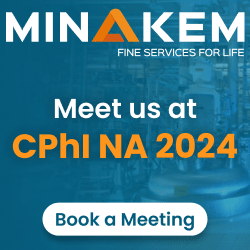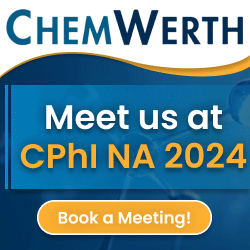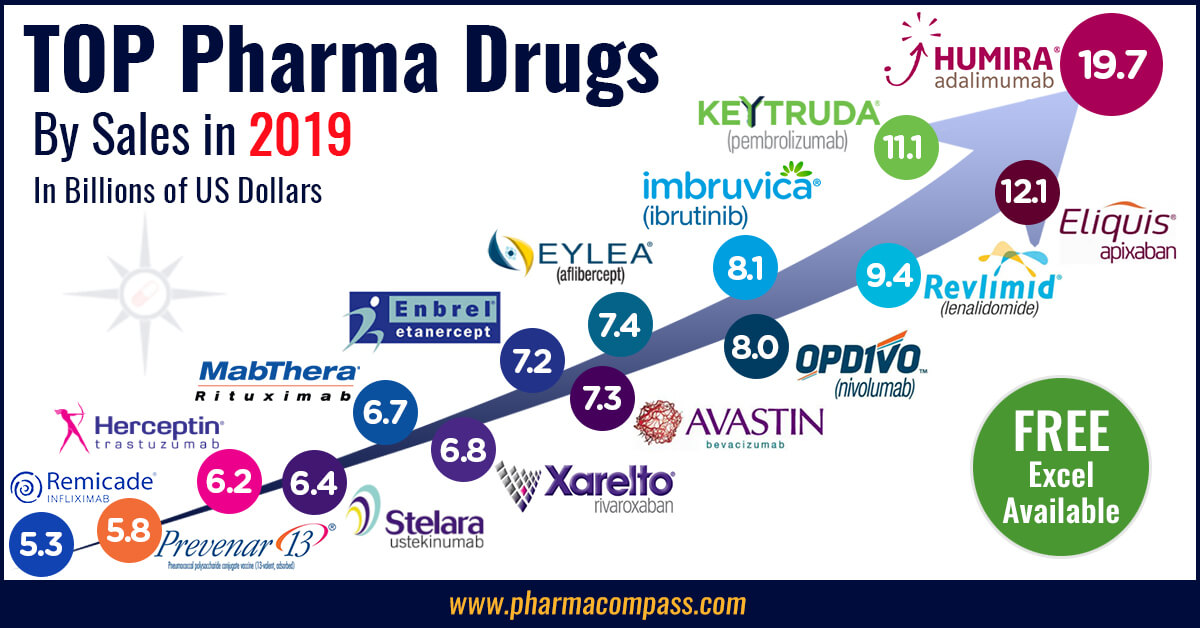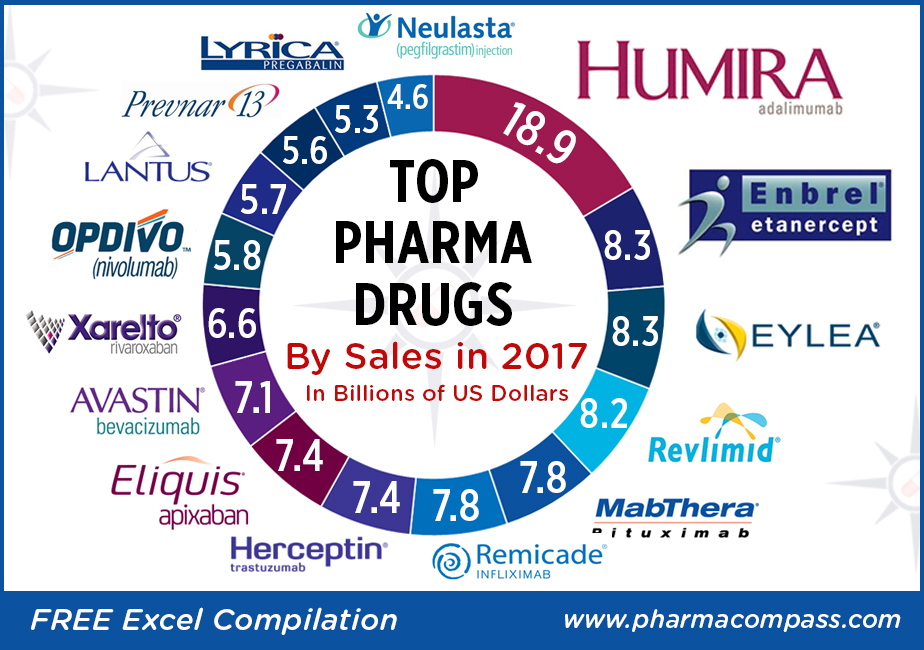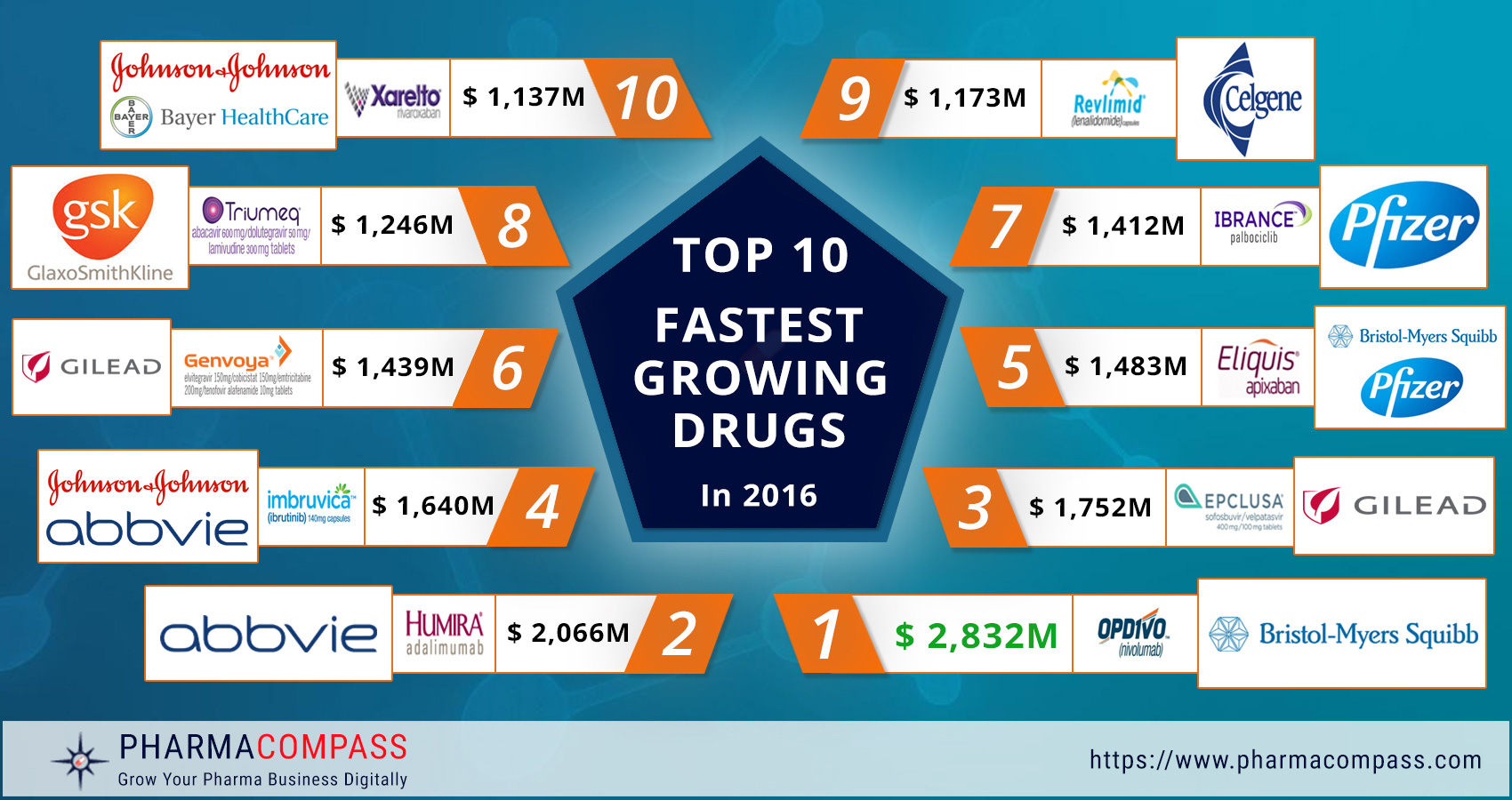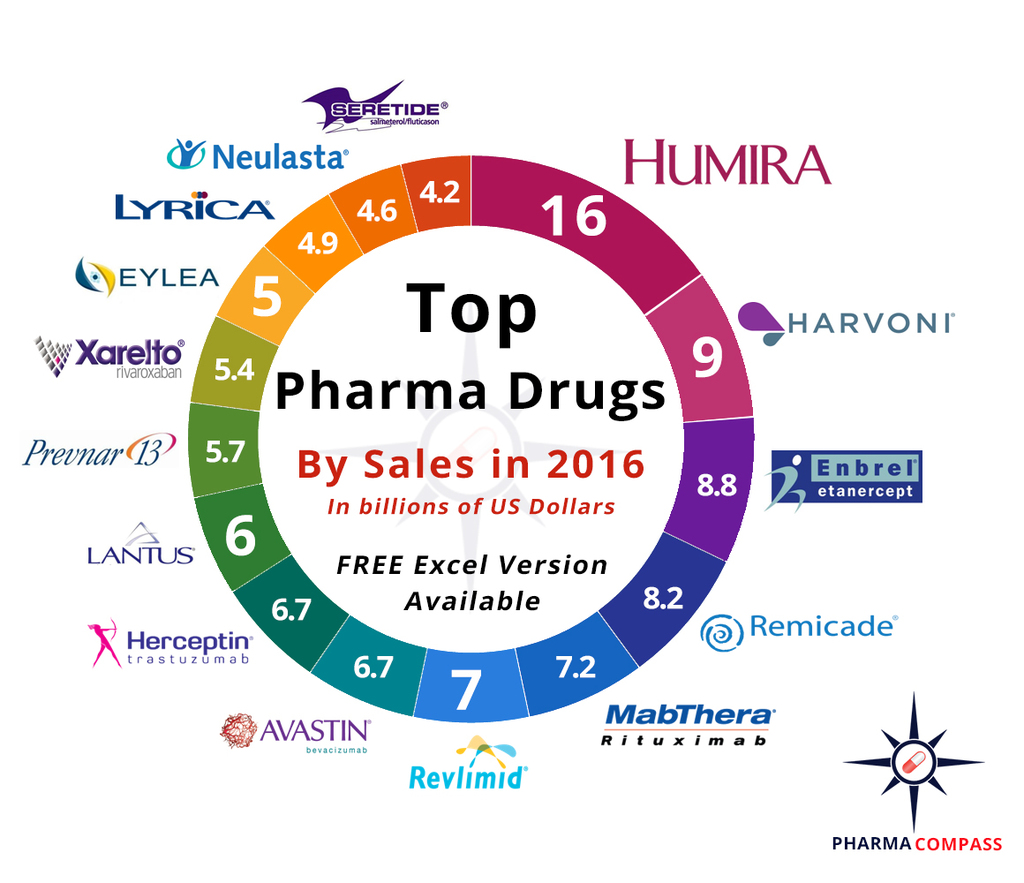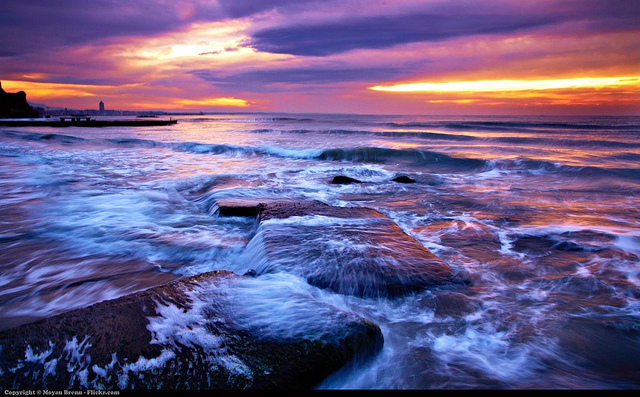Acquisitions and spin-offs dominated headlines in 2019 and the tone was set very early with Bristol-Myers Squibb acquiring
New Jersey-based cancer drug company Celgene in a US$ 74 billion deal announced on
January 3, 2019. After factoring
in debt, the deal value ballooned to about US$ 95 billion, which according
to data compiled by Refinitiv, made it the largest healthcare deal on
record.
In the summer, AbbVie Inc,
which sells the world’s best-selling drug Humira, announced its acquisition of Allergan Plc, known for Botox and other cosmetic
treatments, for US$ 63 billion. While the companies are still awaiting
regulatory approval for their deal, with US$ 49 billion in combined 2019
revenues, the merged entity would rank amongst the biggest in the industry.
View Our Interactive Dashboard on Top drugs by sales in 2019 (Free Excel Available)
The big five by pharmaceutical sales — Pfizer,
Roche, J&J, Novartis and Merck
Pfizer
continued
to lead companies by pharmaceutical sales by reporting annual 2019 revenues of
US$ 51.8 billion, a decrease of US$ 1.9 billion, or 4 percent, compared to
2018. The decline was primarily attributed to the loss of exclusivity of Lyrica in 2019,
which witnessed its sales drop from US$ 5 billion in 2018 to US$ 3.3 billion in
2019.
In 2018, Pfizer’s then incoming CEO Albert Bourla had mentioned that the company did not see the need for any large-scale M&A activity as Pfizer had “the best pipeline” in its history, which needed the company to focus on deploying its capital to keep its pipeline flowing and execute on its drug launches.
Bourla stayed true to his word and barring the acquisition of Array Biopharma for US$ 11.4 billion and a spin-off to merge Upjohn, Pfizer’s off-patent branded and generic established medicines business with
Mylan, there weren’t any other big ticket deals which were announced.
The
Upjohn-Mylan merged entity will be called Viatris and is expected to have 2020
revenues between US$ 19 and US$ 20 billion
and could outpace Teva to
become the largest generic company in the world, in term of revenues.
Novartis, which had
followed Pfizer with the second largest revenues in the pharmaceutical industry
in 2018, reported its first full year earnings after spinning off its Alcon eye
care devices business division that
had US$ 7.15 billion in 2018 sales.
In 2019,
Novartis slipped two spots in the ranking after reporting total sales of US$
47.4 billion and its CEO Vas Narasimhan continued his deal-making spree by buying New
Jersey-headquartered The Medicines Company (MedCo) for US$ 9.7
billion to acquire a late-stage cholesterol-lowering
therapy named inclisiran.
As Takeda Pharmaceutical Co was
busy in 2019 on working to reduce its debt burden incurred due to its US$ 62
billion purchase of Shire Plc, which was announced in 2018, Novartis also purchased
the eye-disease medicine, Xiidra, from the Japanese drugmaker for US$ 5.3 billion.
Novartis’ management also spent a considerable part of 2019 dealing with data-integrity concerns which emerged from its 2018 buyout of AveXis, the
gene-therapy maker Novartis had acquired for US$ 8.7 billion.
The deal gave Novartis rights to Zolgensma,
a novel treatment intended for children less than two years of age with the
most severe form of spinal muscular atrophy (SMA). Priced at US$ 2.1 million,
Zolgensma is currently the world’s most expensive drug.
However,
in a shocking announcement, a month after approving the drug, the US Food and
Drug Administration (FDA) issued a press release on
data accuracy issues as the agency was informed by AveXis that
its personnel had manipulated data which
the FDA used to evaluate product comparability and nonclinical (animal)
pharmacology as part of the biologics license application (BLA), which was
submitted and reviewed by the FDA.
With US$
50.0 billion (CHF 48.5 billion) in annual pharmaceutical sales, Swiss drugmaker
Roche came in at number two position in 2019
as its sales grew 11 percent driven by
its multiple sclerosis medicine Ocrevus, haemophilia drug Hemlibra and cancer medicines Tecentriq and Perjeta.
Roche’s newly introduced medicines generated US$ 5.53 billion (CHF 5.4 billion) in growth, helping offset the impact of the competition from biosimilars for its three best-selling drugs MabThera/Rituxan, Herceptin and Avastin.
In late 2019, after months of increased
antitrust scrutiny, Roche completed
its US$ 5.1 billion acquisition of Spark Therapeutics to strengthen its presence in
gene therapy.
Last year, J&J reported almost flat worldwide sales of US$ 82.1 billion. J&J’s pharmaceutical division generated US$ 42.20 billion and its medical devices and consumer health divisions brought in US$ 25.96 billion and US$ 13.89 billion respectively.
Since J&J’s consumer health division sells analgesics, digestive health along with beauty and oral care products, the US$ 5.43 billion in consumer health sales from over-the-counter drugs and women’s health products was only used in our assessment of J&J’s total pharmaceutical revenues. With combined pharmaceutical sales of US$ 47.63 billion, J&J made it to number three on our list.
While the sales of products like Stelara, Darzalex, Imbruvica, Invega Sustenna drove J&J’s pharmaceutical business to grow by 4 percent over 2018, the firm had to contend with generic competition against key revenue contributors Remicade and Zytiga.
US-headquartered Merck, which is known as
MSD (short for Merck Sharp & Dohme) outside the United States and
Canada, is set to significantly move up the rankings next year fueled by its
cancer drug Keytruda, which witnessed a 55
percent increase in sales to US$ 11.1 billion.
Merck reported total revenues of US$ 41.75 billion and also
announced it will spin off its women’s health drugs,
biosimilar drugs and older products to create a new pharmaceutical
company with US$ 6.5 billion in annual revenues.
The firm had anticipated 2020 sales between US$ 48.8 billion and US$ 50.3 billion however this week it announced that the coronavirus pandemic will reduce 2020 sales by more than $2 billion.
View Our Interactive Dashboard on Top drugs by sales in 2019 (Free Excel Available)
Humira holds on to remain world’s best-selling drug
AbbVie’s acquisition of Allergan comes as the firm faces the expiration of patent protection for Humira, which brought in a staggering US$ 19.2 billion in sales last year for
the company. AbbVie has failed to successfully acquire or develop a major new
product to replace the sales generated by its flagship drug.
In 2019, Humira’s US revenues increased 8.6 percent to US$ 14.86 billion while internationally, due
to biosimilar competition, the sales dropped 31.1 percent to US$ 4.30 billion.
Bristol Myers Squibb’s Eliquis, which is also marketed by Pfizer, maintained its number two position
and posted total sales of US$ 12.1 billion, a 23 percent increase over 2018.
While Bristol Myers Squibb’s immunotherapy treatment Opdivo, sold in partnership with Ono in Japan, saw sales increase from US$ 7.57 billion to US$ 8.0 billion, the growth paled in comparison to the US$ 3.9
billion revenue increase of Opdivo’s key immunotherapy competitor Merck’s Keytruda.
Keytruda took the number three spot in drug sales that
previously belonged to Celgene’s Revlimid, which witnessed a sales decline from US$ 9.69 billion to US$ 9.4 billion.
Cancer treatment Imbruvica, which is marketed
by J&J and AbbVie, witnessed a 30 percent increase in sales. With US$ 8.1
billion in 2019 revenues, it took the number five position.
View Our Interactive Dashboard on Top drugs by sales in 2019 (Free Excel Available)
Vaccines – Covid-19 turns competitors into partners
This year has been dominated by the single biggest health emergency in years — the novel coronavirus (Covid-19) pandemic. As drugs continue to fail to meet expectations, vaccine development has received a lot of attention.
GSK reported the highest vaccine sales of all drugmakers with
total sales of US$ 8.4 billion (GBP 7.16 billion), a significant portion of its
total sales of US$ 41.8 billion (GBP 33.754 billion).
US-based Merck’s vaccine division also reported a significant increase in sales to US$ 8.0 billion and in 2019 received FDA and EU approval to market its Ebola vaccine Ervebo.
This is the first FDA-authorized vaccine against the deadly virus which causes
hemorrhagic fever and spreads from person to person through direct contact with
body fluids.
Pfizer and Sanofi also reported an increase in their vaccine sales to US$ 6.4
billion and US$ 6.2 billion respectively and the Covid-19 pandemic has recently
pushed drugmakers to move faster than ever before and has also converted
competitors into partners.
In a rare move, drug behemoths — Sanofi and GlaxoSmithKline (GSK) —joined hands to develop a vaccine for the novel coronavirus.
The two companies plan to start human trials
in the second half of this year, and if things go right, they will file
for potential approvals by the second half of 2021.
View Our Interactive Dashboard on Top drugs by sales in 2019 (Free Excel Available)
Our view
Covid-19 has brought the world economy to a grinding halt and shifted the global attention to the pharmaceutical industry’s capability to deliver solutions to address this pandemic.
Our compilation shows that vaccines and drugs
for infectious diseases currently form a tiny fraction of the total sales of
pharmaceutical companies and few drugs against infectious diseases rank high on
the sales list.
This could well explain the limited range of
options currently available to fight Covid-19. With the pandemic currently infecting
over 3 million people spread across more than 200 countries, we can safely
conclude that the scenario in 2020 will change substantially. And so should our
compilation of top drugs for the year.
View Our Interactive Dashboard on Top drugs by sales in 2019 (Free Excel Available)
Impressions: 54752
The year 2017 was a landmark year for pharmaceutical
industries in the US and Europe, with a sharp increase in the number of new molecular entities (NMEs) being approved in both geographies.
The US Food
and Drug Administration (USFDA) approved 46 NMEs in 2017, the second highest
since 1996 when 53 NMEs were approved. In Europe, the European Medicines Agency
(EMA) approved 35 drugs with a new active substance, up from 27 in 2016.
Sales for most major pharmaceutical
companies continued to grow in 2017. Earnings forecasts for 2018 have been raised due to the recent US tax reform that has
generated investor hopes for accelerated dividend growth and share buyback
plans.
This week, PharmaCompass brings
you a compilation of the top drugs of 2017 by sales revenue.
Click here to Access All the 2017 Data (Excel
version available) for FREE!
Top-sellers: Humira races ahead, despite launch of biosimilars; Enbrel a distant second
There wasn’t any upheaval
at the top of the pharma drug sales charts. AbbVie’s anti-TNF (tumor necrosis factor) giant
Humira (adalimumab), which is approved to treat
psoriasis and rheumatoid arthritis, added
almost another US $3 billion to its 2016 sales and posted nearly US $19 billion in revenues.
Last year, AbbVie’s raised expectations for Humira’s earnings to reach US $21 billion in global sales by 2020. The
company believes this drug will continue to be a significant cash contributor
until 2025 and the US $21 billion sales forecast
by 2020 is about US $3 billion higher than its expectation two years ago.
In 2016, the US Food and Drug Administration
(FDA) approved Amgen’s Amjevita (adalimumab-atto) — a biosimilar of Humira. And in 2017, another Humira biosimilar — Boehringer Ingelheim’s Cyltezo
(adalimumab-adbm) — received approval from the FDA and European authorities.
Click here to Access All the 2017 Data (Excel
version available) for FREE!
Enbrel (etanercept),
the longest-used biologic medicine for the treatment of rheumatism around the
world, was the second best-selling drug with US $8.262 billion in 2017 sales.
The sales of the drug were down from US $9.366 billion in
2016 owing to lower selling prices and increased
competition, which in turn hurt demand.
Since it was first approved in the United States in 1998,
Enbrel has been approved in over 100 countries and the drug is promoted by Amgen,
Pfizer
and Takeda
in different geographies.
Novartis’ biosimilar copy of Enbrel, which got approved by the FDA in August
2016 for the treatment of patients with
rheumatoid arthritis (RA), plaque psoriasis, ankylosing spondylitis (AS) and
other diseases is still not on the market because of a patent-protection
challenge from Amgen.
Amgen is arguing in the US federal court
that its drug has patent protection until 2029.
Click here to Access All the 2017 Data (Excel
version available) for FREE!
Fast-growing drugs: Eylea and Revlimid bring
fortunes for Regeneron and Celgene
Regeneron’s
flagship eye treatment, Eylea (aflibercept) which is marketed by Bayer outside the United States, added another US $1 billion in
annual sales last year to record US $8.260 billion in total sales. Eylea net
sales grew 11 percent year-on-year in the US and 19 percent year-over-year
outside the US.
The company believes much of the recent
growth in the US was driven by demographic trends with an aging population as
well as an overall increase in the prevalence of diabetes.
These demographic trends are expected to
continue in the coming years, providing an opportunity for continued growth.
Eylea sales alone contribute 63 percent to Regeneron’s total sales.
Click here to Access All the 2017 Data (Excel
version available) for FREE!
Celgene’s
Revlimid
(lenalidomide)
— a thalidomide derivative introduced in 2004 as an immunomodulatory agent for the treatment of various cancers such as multiple myeloma — brought in an additional US $1.2 billion in 2017 sales and had total revenues of US $8.187 billion.
Revlimid continues to contribute more than 60 percent to the company’s total sales of US $13 billion.
Celgene received a setback this month as the
USFDA refused to consider Celgene’s
application for ozanimod, an experimental
treatment for relapsing multiple sclerosis. The treatment was being seen as a
key to the company’s fortunes as Celgene had
said ozanimod is worth US $4 billion to
US $6
billion a year in peak sales.
Click here to Access All the 2017 Data (Excel
version available) for FREE!
Gilead’s Hepatitis C franchise enters free fall
Gilead Sciences’ blockbuster hepatitis C drugs franchise that includes Sovaldi and Harvoni continue to feel the
competitive heat as they registered US $9.137
billion in 2017 sales, down from US $14.834
billion the previous year.
While reporting 2017 results, Gilead provided guidance for
2018 and said its sales of Hepatitis C drugs could fall
further to US $3.5 billion - US $4 billion. At their peak in 2015, Gilead’s Sovaldi and Harvoni had together generated
US $19.1 billion in sales.
One of the major reasons for this drop is AbbVie’s launch of its new treatment Mavyret
at a deep price discount to the competition. AbbVie
also claims to have the shortest treatment course at eight weeks, compared with
12 weeks or longer for other treatments.
AbbVie reported US $1.274 billion in Hepatitis C drug sales
in 2017, down from US $1.522 billion in 2016.
Click here to Access All the 2017 Data (Excel
version available) for FREE!
Novartis’ Gleevec, Merck’s cardiovascular drugs, GSK’s Advair face generic heat
Novartis’ Gleevec (imatinib), which had at one point become the best-selling drug for Novartis and had brought in US $3.323 billion for the company in 2016, started facing generic competition last year and the anti-cancer drug lost US $1.380 billion in sales to bring in ‘only’ US $1.943 billion last year.
The US patents of Merck’s cardiovascular drugs — Zetia (Ezetimibe)
and Vytorin (Ezetimibe
and Simvastatin) — expired in April 2017. In May 2010, Merck and Glenmark
Pharmaceuticals entered into an agreement that allowed Glenmark to launch
a generic version of Zetia in late 2016. The drugs
that had combined sales of US $3.701
billion in 2016 felt the generic heat in 2017 and the sales were US
$1.606 billion lower at US $2.095
billion.
Click here to Access All the 2017 Data (Excel
version available) for FREE!
GSK’s Advair, which was expected
to encounter generic competition in 2017, continued to breathe easy as the FDA
found deficiencies in the applications of Hikma, Mylan and Sandoz.
All three failed to get the FDA nod for their generic versions of Advair, a drug used in the management of asthma and chronic obstructive pulmonary disease that generated sales worth US $4.431 billion (£3.130 billion) in 2017.
Top 15 drugs by sales
Here is PharmaCompass’ compilation
of the best-selling drugs of 2017. This is based on information extracted from
annual reports and US Securities and Exchange Commission (SEC) filings of major
pharmaceutical companies.
If you would like your own copy of all the information we’ve collected, email us at support@pharmacompass.com and we’ll send you an Excel version.
Click here to access all the 2017 data (Excel
version available) for FREE!
S. No.
Company / Companies
Product Name
Active Ingredient
Main Therapeutic Indication
2017 Revenue in Millions (USD)
1
AbbVie Inc., Eisai
Humira®
Adalimumab
Immunology (Organ Transplant, Arthritis etc.)
18,946
2
Amgen, Pfizer Inc., Takeda
Enbrel®
Etanercept
Immunology (Organ Transplant, Arthritis etc.)
8,262
3
Regeneron, Bayer
Eylea
Aflibercept
Ophthalmology
8,260
4
Celgene
Revlimid
Lenalidomide
Oncology
8,187
5
Roche
MabThera®/Rituxan®
Rituximab
Oncology
7,831
6
Johnson & Johnson, Merck, Mitsubishi Tanabe
Remicade®
Infliximab
Autoimmune Disorders
7,784
7
Roche
Herceptin®
Trastuzumab
Oncology
7,435
8
Bristol-Myers Squibb, Pfizer Inc.
Eliquis®
Apixaban
Cardiovascular Diseases
7,395
9
Roche
Avastin®
Bevacizumab
Oncology
7,089
10
Bayer, Johnson & Johnson
XareltoTM
Rivaroxaban
Cardiovascular Diseases
6,590
11
Bristol Myers Squibb, Ono Pharmaceutical
Opdivo
Nivolumab
Oncology
5,815
12
Sanofi
Lantus
Insulin Glargine
Diabetes
5,731
13
Pfizer Inc.
Prevnar 13/Prevenar 13
Pneumococcal 7-Valent Conjugate
Anti-bacterial
5,601
14
Pfizer Inc., Eisai
Lyrica
Pregabalin
Neurological/Mental Disorders
5,318
15
Amgen, Kyowa Hakko Kirin
Neulasta®
Pegfilgrastim
Blood Disorders
4,553
Sign up, stay ahead
In order to stay informed, and receive
industry updates along with our data compilations, do sign up for the PharmaCompass Newsletter and
you will receive updated information as it becomes available along with a lot
more industry analysis.
Click here to Access All
the 2017 Data (Excel version available) for FREE!
Impressions: 58407
Global
pharmaceutical companies are increasingly focusing on the development of new
biologics. In fact, in 2016, nine out of the top
15 pharmaceutical drugs by sales were of biologic origin. This makes us wonder
what the future holds for manufacturers specializing in drugs that originate
from chemical synthesis.
This
week, PharmaCompass continued its analysis of the top pharma drugs by
sales to evaluate the drugs that registered large sales growth in 2016.
Click here to Access All the 2016 Data (Excel version available) for FREE!
Please
note that these are not the top-selling drugs, but are the top 10 drugs that
registered the maximum growth in global sales over 2015.
Interestingly, things didn’t appear that bad for drugs originating from chemical synthesis — while the top two drugs on the list were biologics, the remaining originated from chemical synthesis.
Here’s a list of drugs that witnessed the largest sales growth in 2016:
1. Opdivo (nivolumab) – Bristol-Myers Squibb
2016
sales: US$ 3,774 million
2015 sales:
US$ 942 million
Sales
growth: US$ 2,832 million
First
approved in 2014, Bristol-Myers Squibb’s Opdivo and Merck’s Keytruda — also known as checkpoint inhibitors — continued to stay on track to be among the top 20 best-selling drugs in the world by 2020. They represent the hot new field of immunotherapy and are known to have given 90-year old Jimmy Carter (former President of the United States) hope in his fight against cancer.
With
a sales growth of US$ 2.832 billion, Opdivo registered the highest sales growth
of any single drug in 2016. However, Bristol-Myers Squibb received a nasty
surprise last year when Opdivo did not demonstrate the desired slowdown in the
progress of advanced lung cancer in a trial, as compared to conventional
chemotherapy.
While Bristol-Myers’ stock price plunged on this news, Merck announced that not only did Keytruda succeed in a clinical trial as an initial treatment for advanced non-small cell lung cancer, but patients actually lived longer. Although Keytruda did not make it to our list of top 10 drugs by sales growth in 2016, it did register a sales increase of US$ 836 million, as its sales grew from US$ 566 million to US$ 1,402 million.
Click here to Access All the 2016 Data (Excel version available) for FREE!
2. Humira (adalimumab) – AbbVie
2016
sales: US$ 16,078 million
2015
sales: US$ 14,012 million
Sales
growth: US$ 2,066 million
Abbvie’s Humira (adalimumab)
juggernaut continued as it not only remained the best-selling drug in the
world, but also added another US$ 2 billion to its 2015 sales by generating
record sales of US $16.078 billion in 2016.
Last
year, the US Food and Drug Administration (FDA) approved Amgen’s Amjevita™ (adalimumab – atto) — a biosimilar of Humira®. Therefore, it remains to be seen if Humira will be able to sustain the momentum. Amjevita was approved for treating adults with a variety of medical conditions ranging from rheumatoid arthritis, plaque psoriasis, to ulcerative colitis.
3. Epclusa (sofosbuvir and velpatasvir) – Gilead
2016
sales: US$ 1,752 million (new launch)
Gilead’s third sofosbuvir-based regimen — Epclusa (sofosbuvir and velpatasvir) was approved by the US FDA in June 2016. It is the first and only all-oral, pan-genotypic single tablet regimen for chronic Hepatitis C virus infection. While Epclusa registered an impressive start, Gilead's other two sofosbuvir-based treatments — Sovaldi (sofosbuvir) and Harvoni (sofosbuvir and lepidasvir) — saw their combined sales decline by almost US$ 6 billion.
Click here to Access All the 2016 Data (Excel version available) for FREE!
4. Imbruvica (ibrutinib) — Johnson & Johnson / AbbVie
2016
sales: US$ 3,083 million
2015
sales: US$ 1,443 million
Sales
growth: US$ 1,640 million
Abbvie’s 2015 US$ 21 billion buy of Pharmacyclics seems to be paying off.
The Pharmacyclics buy was a way to get access to Imbruvica (ibrutinib), a cancer drug which
is co-marketed with Johnson & Johnson. It generated sales of US$ 3.083 billion in 2016. Imbruvica works by blocking a specific protein called Bruton’s tyrosine kinase (BTK). In December 2011, Johnson & Johnson said it would pay Pharmacyclics as much as US$ 975 million to fund getting the drug to market in exchange for half the profits generated globally.
5. Eliquis (apixaban) -
Bristol-Myers Squibb / Pfizer
2016
sales: US$ 3,342 million
2015
sales: US$ 1,860 million
Sales
growth: US$ 1,483 million
Although
apixaban was the third-to-market
novel oral anticoagulant (NOAC), which is co-promoted by Pfizer and Bristol-Myers Squibb as Eliquis, it continues to unseat Johnson & Johnson’s Xarelto (rivaroxaban) as the leader in its
class based on total prescriptions. Rivaroxaban's total 2016 sales were US$
5.392 billion.
While Pfizer’s reports its sales as part of Alliance revenues, and exact sales are not known, Bristol-Myers Squibb results alone put Eliquis in the top 10 list. Generics are hot on their tail as, last month, Pfizer and Bristol-Myers’ filed suits against 16 generic makers to uphold their patents for apixaban.
6. Genvoya (elvitegravir,
cobicistat, emtricitabine, tenofovir alafenamide) — Gilead
2016
sales: US$ 1,484 million
2015
sales: US$ 45 million
Sales
growth: US$ 1,439 million
Genvoya has been the most
successful HIV treatment launch since the introduction of Atripla (the first
single-tablet regimen launched a decade ago). Gilead is the dominant HIV
player in the US market and has the top three most-prescribed HIV regimens in
the US.
Genvoya
adds Tenofovir Alafenamide (TAF) to already known
treatments. TAF based drugs have demonstrated a better safety profile. They
would also allow Gilead to maintain its dominance in the HIV market.
Click here to Access All the 2016 Data (Excel version available) for FREE!
7. Ibrance (palbociclib) — Pfizer
2016
sales: US$ 2,135 million
2015
sales: US$ 723 million
Sales
growth: US$ 1,412 million
Discovered
in Pfizer laboratories and approved by the US
FDA in February 2015, Ibrance is used in combination
with Letrozole as a first-line
treatment of postmenopausal women with estrogen receptor-positive, human
epidermal growth factor receptor 2-negative (ER+/HER2-) metastatic breast
cancer.
8. Triumeq (abacavir,
dolutegravir, lamivudine) – GlaxoSmithKline
2016
sales:US$ 2,151 million
2015
sales: US$ 905 million
Sales
growth: US$ 1,246 million
GlaxoSmithKline's HIV drugs business — ViiV Healthcare — has been enjoying sales growth with the introduction of Triumeq ® in its portfolio. While GSK is the major shareholder in ViiV Healthcare, Pfizer and Shionogi also have a stake. Triumeq® is the company’s first fixed-dose combination tablet for a once-daily single pill regimen that combines dolutegravir, an integrase inhibitor, with the nucleoside reverse transcriptase inhibitors — abacavir and lamivudine.
9. Revlimid (lenalidomide) – Celgene
2016
sales: US$ 6,974 million
2015
sales: US$ 5,801 million
Sales
growth: US$ 1,173 million
Celgene’s Revlimid (lenalidomide) — a thalidomide-derivative introduced in 2004 as an immunomodulatory agent for the treatment of various cancers such as multiple myeloma — brought in US$ 5.8 billion in 2015, and grew another 20 percent this year, to US $6.974 billion. Revlimid now contributes more than 60 percent to Celgene's total sales of US$ 11.229 billion.
10. Xarelto (rivaroxaban) – Johnson & Johnson (US) and Bayer
2016
sales: US$ 5,392 million
2015
sales: US$ 4,255 million
Sales
growth: US$ 1,137 million
Bayer’s Xarelto, which is promoted by Johnson & Johnson in the United States, provided patients with an alternative to the old-guard therapy — warfarin. While rivaroxaban is competing with other
novel oral anticoagulants (NOAC) like Eliquis (apixaban) and Pradaxa (dabigatran), rivaroxaban has the
class lead in indications.
Xarelto
recently posted positive results in a large-scale Phase 3 study —COMPASS, involving 27,402 patients, that assessed the effect of the
blood thinner in preventing major adverse cardiac events (MACE).
The
trial was stopped a year early
on the advice of an independent Data Monitoring Committee, after the primary
endpoint of prevention of MACE (which includes cardiovascular death, myocardial
infarction and stroke) reached its pre-specified criteria for superiority over aspirin.
Click here to Access All the 2016 Data (Excel version available) for FREE!
Our
view
In QuintilesIMS Institute’s new annual drug spending report, analysts have forecasted that
over the coming five years the industry should continue to receive 40 to 45 new
drug approvals every year.
A quarter of all the drugs in late-stage development are now
focused on oncology. The rate of oncology drug development has hit such a
rapid pace that new drugs are superseding old ones in a matter of a few years.
It’s clear that this compilation will see radical changes next year. However, with eight out of the 10 fastest-selling drugs coming from chemical synthesis, traditional generic manufacturers still have a lot of opportunities to explore.
Sign up,
stay ahead
In order to stay informed,
and receive industry updates along with our data compilations, do sign up for
the PharmaCompass Newsletter and you will receive updated information as
it becomes available along with a lot more industry analysis.
Click here to Access All the 2016 Data (Excel version available) for FREE!
Impressions: 9289
The year 2016 finished with a whimper insofar as mergers and acquisitions (M&As) were concerned. The preceding year — 2015 — had gone down in history as a record year for M&As in the pharmaceutical and biotech space, when deals worth US $300 billion were announced.
While drug companies were not as active on
the M&A front, the product sales growth in 2016 continued to stay extremely
robust and the order of the top ranked drugs changed little from the previous
year.
This week, PharmaCompass brings you
a compilation of the top drugs of 2016 by sales revenue.
Click here to Access All the
2016 Data (Excel version available) for FREE!
The top-sellers
Abbvie’s Humira (adalimumab) continued to remain the best-selling drug in the
world and added another US $2 billion to its 2015 sales by generating record
sales of US $16.078 billion in 2016.
Last year also saw the US Food and Drug Administration (FDA) approve Amgen’s Amjevita™ (adalimumab – atto) — a biosimilar of Humira®. Amjevita was approved for treating adults with a variety of medical conditions ranging from rheumatoid arthritis, plaque psoriasis, to ulcerative colitis.
Click here to Access All the
2016 Data (Excel version available) for FREE!
Gilead’s Harvoni (ledipasvir and sofosbuvir), with record sales of US $13.864 billion in 2015, had a slightly muted performance in 2016 as sales fell to US $9.081 billion (a drop of US $4.783 billion). Gilead failed to maintain its initial rate of new prescriptions, and competition from Merck and AbbVie forced it to offer major discounts to health insurers.
While Gilead executives still believe there is lots of growth left in the hepatitis C market, this year Gilead will continue to face headwinds as Merck's new combination pill — Zepatier — entered the market with a list price at US $54,600 for a 12-week regimen, well below the US $94,500 for Harvoni.
Biological drugs, Enbrel (etanercept),
Remicade (infliximab) and MabThera (rituximab), held onto their positions of 2015, although their combined sales increased a little over US $300
million.
This means that for yet another year, the
four best-selling drugs in the world are from biological origin.
Celgene’s Revlimid (lenalidomide) — a thalidomide derivative introduced in 2004 as an immunomodulatory agent for the treatment of various cancers such as multiple myeloma — brought in US $5.8 billion in 2015, and grew another 20 percent this year, to US $6.974 billion. Revlimid now contributes more than 60 percent to the company's total sales of US $11.229 billion.
With almost identical sales of US $6.7
billion, Roche’s cancer treatments Herceptin and Avastin were also into
the top 10 best selling drugs in 2016, making Roche have the most number of
products, three of which made it to the list.
Click here to Access All the
2016 Data (Excel version available) for FREE!
Facing onslaught of generics, biosimilars
Against the backdrop of questions being raised about
insulin pricing and possible collusion in the United States, Sanofi saw its insulin treatment Lantus (insulin glargine) drop from number six on the 2015 list to number 9 in 2016 as sales fell by US $717 million to a little over US $6 billion. Sanofi’s competitors in the diabetes space — Novo Nordisk and Eli Lilly — also registered a drop in their insulin sales.
In addition to the pricing pressure, Sanofi will continue to contend with Lilly and Boehringer Ingelheim’s FDA approved biosimilar of insulin glargine — Basaglar — which was approved in December 2015.
Click here to Access All the
2016 Data (Excel version available) for FREE!
Basaglar is biologically similar to Sanofi’s Lantus and was announced at a price 15 percent lower than that of Lantus.
GSK’s Advair, which is preparing for generic competition in 2017, saw its sales drop 5 percent in British Pounds to £3,485. However, the dollar value was significantly lower in view of the fall in the Pound’s value after Brexit.
AstraZeneca’s Crestor (rosuvastatin calcium), Otsuka’s Abilify (aripiprazole) and Novartis’ Gleevec (imatinib) all saw their sales crash in 2016 as a result of generic onslaught. The three drugs together witnessed a combined sales drop of US $5.7 billion.
Top 20 drugs by sales
Here is PharmaCompass’ compilation
of the best-selling drugs of 2016. This is based on information extracted from
annual reports and US Securities and Exchange Commission (SEC) filings of major
pharmaceutical companies.
If you would like your own copy of all the information we’ve collected, email us at support@pharmacompass.com and we’ll send you an Excel version.
Click
here to access all the 2016 data (Excel version available) for FREE!
S. No
Product
Active Ingredient
Main Therapeutic Indication
Company
2016 Revenue in Millions (USD)
2015 Revenue in Millions (USD)
Sales Difference in Millions (USD)
1
Humira
Adalimumab
Immunology (Organ Transplant, Arthritis etc.)
Abbvie
16,078
14,012
2,066
2
Harvoni
Ledipasvir and Sofosbuvir
Infectious Diseases (HIV, Hepatitis etc.)
Gilead
9,081
13,864
(4,783)
3
Enbrel
Etanercept
Immunology (Organ Transplant, Arthritis etc.)
Amgen/Pfizer Inc.
8875
8697
178
4
Remicade
Infliximab
Immunology (Organ Transplant, Arthritis etc.)
Johnson & Johnson/Merck & Co
8,234
8,355
(121)
5
MabThera/Rituxan
Rituximab
Oncology
Roche
7227
6974.55
252
6
Revlimid
Lenalidomide
Oncology
Celgene
6,974
5,801
1,173
7
Avastin
Bevacizumab
Oncology
Roche
6,715
6,617
98
8
Herceptin
Trastuzumab
Oncology
Roche
6,714
6,473
242
9
Lantus
Insulin Glargine
Diabetes
Sanofi
6,057
6,773
(717)
10
Prevnar/Prevenar
13
Pneumococcal 13-Valent Conjugate
Anti-bacterial
Pfizer Inc.
5,718
6,246
(528)
11
Xarelto
Rivaroxaban
Cardiovascular Diseases
Bayer/Johnson & Johnson
5,392
4,255
1,137
12
Eylea
Aflibercept
Ophthalmology
Regeneron Pharmaceuticals, Inc./Bayer
5,046
3,978
1,068
13
Lyrica
Pregabalin
Neurological/Mental Disorders
Pfizer Inc.
4,966
4,839
127
14
Neulasta
Pegfilgrastim
Blood Disorders
Amgen
4,648
4,715
(67)
15
Seretide/Advair
Salmeterol
Respiratory Disorders
GlaxoSmithKline
4,252
4,491
(239)
16
Copaxone
Glatiramer
Neurological/Mental Disorders
Teva
4,223
4,023
200
17
Sovaldi
Sofosbuvir
Infectious Diseases (HIV, Hepatitis etc.)
Gilead
4,001
5,276
(1,275)
18
Tecfidera
Dimethyl Fumarate
Neurological/Mental Disorders
Biogen
3,968
3,638
330
19
Januvia
Sitagliptin
Diabetes
Merck & Co
3,908
3,864
44
20
Opdivo
Nivolumab
Oncology
Bristol-Myers Squibb
3,774
942
2,832
Blockbusters in the making
With almost US $5 billion in sales, a 14 percent growth over the previous year, Pfizer’s Lyrica enjoyed its last year before generic competition enters the market as Generics (UK) Limited (Mylan) and Actavis Group PTC ehf won a patent challenge in the United Kingdom.
Lyrica generics are expected in the United
States in late 2018.
Click here to Access All the
2016 Data (Excel version available) for FREE!
As Abbvie’s Humira begins to face competition from Amgen, Abbvie’s US $21 billion buy of Pharmacyclics seems to be paying off. The Pharmacyclics buy was a way to get access to Imbruvica (ibrutinib), which generated total 2016 sales of US $3.083 billion — an increase of US $1.64 billion over the previous year.
Anticoagulants, Xarelto (rivaroxaban), Eliquis (apixaban), Pradaxa (dabigatran) all registered significant positive growth with a combined increase of almost US $ 2.75 billion.
Gilead and GSK’s combination HIV treatments — Genvoya and Triumeq — also reported sales increase of over a billion dollars each.
Sign up,
stay ahead
In order to stay informed, and receive
industry updates along with our data compilations, do sign up for the PharmaCompass
Newsletter and you will receive updated information as it becomes available
along with a lot more industry analysis.
Click here to Access All the
2016 Data (Excel version available) for FREE!
Impressions: 58546
This week’s Phispers has regulatory and M&A news from across the world as Pfizer ends its support to drugs used in lethal injections, Endo’s problems get compounded and Thalidomide’s Nazi war criminal links are uncovered. European regulators to ‘rely more’ on FDA inspectionsSince the US Department of Justice imposed a US $ 500
million fine on Indian drug manufacturer Ranbaxy in 2013, we have seen regulatory concerns over globalization of drug manufacturing. The Ranbaxy controversy also demonstrated differences in the approaches of regulators in the EU and the US. While the US FDA banned the import of products from two of Ranbaxy’s factories into the US, no such move was taken by the European regulator, the European Medicines Agency (EMA). “A legal framework will allow us to be able to rely
more on US inspections,” Emer Cooke, head of international affairs at the EMA, said in a news report. “That will allow us to release resources to adopt a more risk-based approach.” This statement manifests that European regulators rely more
on FDA inspections, than on their own. Cooke was referring to the need for
Transatlantic Trade and Investment Partnership, a partnership between the EU
and the US to better channel scarce resources between the two regions. Data-integrity issues uncovered at Capsugel’s U.S. plant Problems of data-integrity don’t seem limited only to Asia as Sweden’s regulator, Medical Products Agency (MPA), uncovered “two critical and one major concerns” related to data-integrity at Capsugel’s Bend Research Inc. facility in Oregon. The inspectors also found that several findings, from two previous MPA inspections, had not been corrected and concluded that the facility had an “unacceptable level of GMP compliance”.Bend
Research makes oral solid dose products, primarily for clinical trials and was acquired
by Capsugel
in 2013. Capsugel subsequently invested $20m in to add commercial
spray drying capacity at the Oregon site. Mylan and Pfizer put skin in the game by
investing billionsThis week, both Mylan NV and Pfizer made
acquisitions in the dermatology/topicals space.
Mylan NV announced its decision to
buy skin drug assets from Renaissance Acquisition Holdings LLC for around
US $ 1 billion to complement its existing products. Pfizer, on the other hand, will buy Anacor Pharmaceuticals – a biopharmaceutical company – for US $ 4.5 billion. This is said to be Pfizer’s Plan B, post the collapse of the Allergan mega deal. Pfizer CEO Ian Read had earlier said Pfizer will shop for deals to beef up the “innovative” side of its business. Anacor is “a strong fit” with Pfizer’s inflammation and immunology group, said Albert Bourla, group president of the Pfizer division that includes innovative pharma. The acquisition is “expected to enhance near-term revenue growth for the innovative business.” For instance, Anacor’s eczema therapy, crisaborole, should bring in US $ 2 billion in annual sales. “The dermatology/topicals space has long been an area of focus for Mylan and one that we have targeted for expansion,” Heather Bresch, Mylan’s chief executive officer, said. Pfizer ends support to drugs used in lethal
injectionsLast week, Pfizer took a milestone
step and announced it had imposed sweeping controls on the distribution of
its products to ensure that none are used in lethal injections. This is a step that closes the last remaining open-market
source of drugs used in executions. Such restrictions have already been adopted
by over 20 American and European drug companies. They have cited moral or
business reasons to take such steps. “With Pfizer’s announcement, all FDA-approved manufacturers of any potential execution drug have now blocked their sale for this purpose,” said Maya Foa, who tracks drug companies for Reprieve, a London-based human rights advocacy group. Thalidomide’s inventor knew about its risks before marketing it, says filmVancouver
documentary director John Zaritsky who has made his third film this year on Thalidomide – the
devastating drug that caused thousands of birth defects before being pulled out of the market in the early 1960s – has revealed an interesting finding in his latest film ‘No Limits’. The world premiere of the film took place on May 7, as part of Vancouver’s DOXA festival. According to the film, developers of the drug were war criminals in Nazi Germany. It also shows how today’s developing world is still marketing thalidomide as treatment for leprosy — leading to the birth of deformed babies. The drug maker – Grunenthal – continues to operate. According to the film, Grunenthal researcher and Thalidomide’s inventor, Heinrich Mueckter, had been a doctor at the Buchenwald concentration camp, performing experiments on prisoners. Mueckter
became a multi-millionaire through Thalidomide sales. The documents revealed
that Grunenthal knew months before putting Thalidomide on the market that their
drug would produce malformed babies. They still went ahead and made fortunes
off the drug. China’s Fosun group makes billion dollar bid for India’s Gland PharmaThis
week, Shanghai
Fosun Pharmaceutical (Group) announced it has made a
non-binding bid for India’s Gland
Pharma Ltd,
the Hyderabad-based injectable drugs manufacturer. According
to a Reuters news report, Gland Pharma founders and KKR, which jointly own
about 96 percent of the company, are selling their combined stake, which is
valued at US $ 1 billion and US $ 1.5 billion respectively. Global
buyout firm Advent International and US-based Baxter
International are also said to be among the companies interested in buying out
Gland Pharma. Shanghai Fosun said the proposal was made through its unit Fosun
Industrial Co Ltd. More trouble for Endo as Mylan, Novartis eye Teva’s generic portfolioAfter the disappointing guidance which caused Endo’s stock price to crash last week, the Federal Trade Commission (FTC) attacked Endo for delaying the launch of an authorized generic. The FTC filed a complaint
in a district court in Pennsylvania against Endo, Impax, Watson
Laboratories and others, alleging the companies violated the FTC Act by entering into no-AG commitments, among other things on two of its “most important branded prescription drug products,’’ Opana ER, an opioid drug, and Lidoderm, a lidocaine patch.Meanwhile Endo’s arch rival Teva’s drug portfolio in the UK, Ireland and Iceland is attracting bidders such as Mylan NV
and Novartis AG. According
to reports, private equity firms such as Apollo Global Management and Cinven
are weighing bids for Teva, which could fetch US $ 1.5 to US $ 2 billion. Teva is selling assets as it works to get regulatory approval for its US $ 40.5 billion acquisition of Allergan Plc’s generics business. Envoy warns Colombia government about its
efforts to override Novartis patentLast month, a Colombian embassy official sent a memo to the foreign
minister of his country warning the government about its efforts to override a
patent on a cancer drug made by Novartis. According to the official, such efforts
could harm US support for peace initiative in Colombia. According to
reports, the Colombian health ministry has been planning to issue a compulsory
license for Gleevec (also marketed as Glivec) – a leukemia treatment – which would allow generic drug makers to manufacture a cheaper version of the drug. Novartis has strongly opposed the move. The leaked memo was posted by Knowledge Ecology International and
states that the US Trade Representative and staffers from the Senate Finance
Committee requested to meet embassy officials to discuss US concerns with
Colombia's plans. Gilead gets Sovaldi patent in India amid protests
by patient groupsIn a politically sensitive move, the Indian Patent Office (IPO) reversed
course and granted a patent to Gilead
Sciences for its Sovaldi
hepatitis C treatment. This way, the IPO earned the wrath of many patient groups, while
handing Gilead an unexpected victory. The decision came in response to a
challenge to the Gilead patent filed by several patient advocacy groups and
companies that make pharmaceutical ingredients. Last year, the IPO had rejected
the company’s patent application on grounds that it was not a significant
improvement over an earlier compound developed by Gilead.
Impressions: 3021







